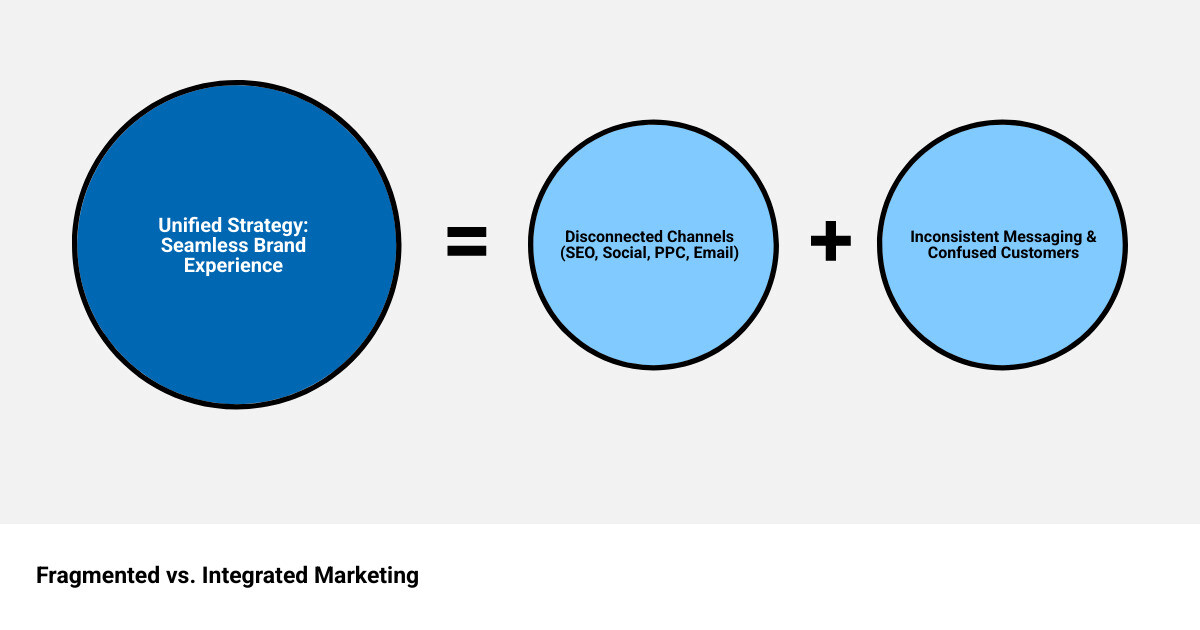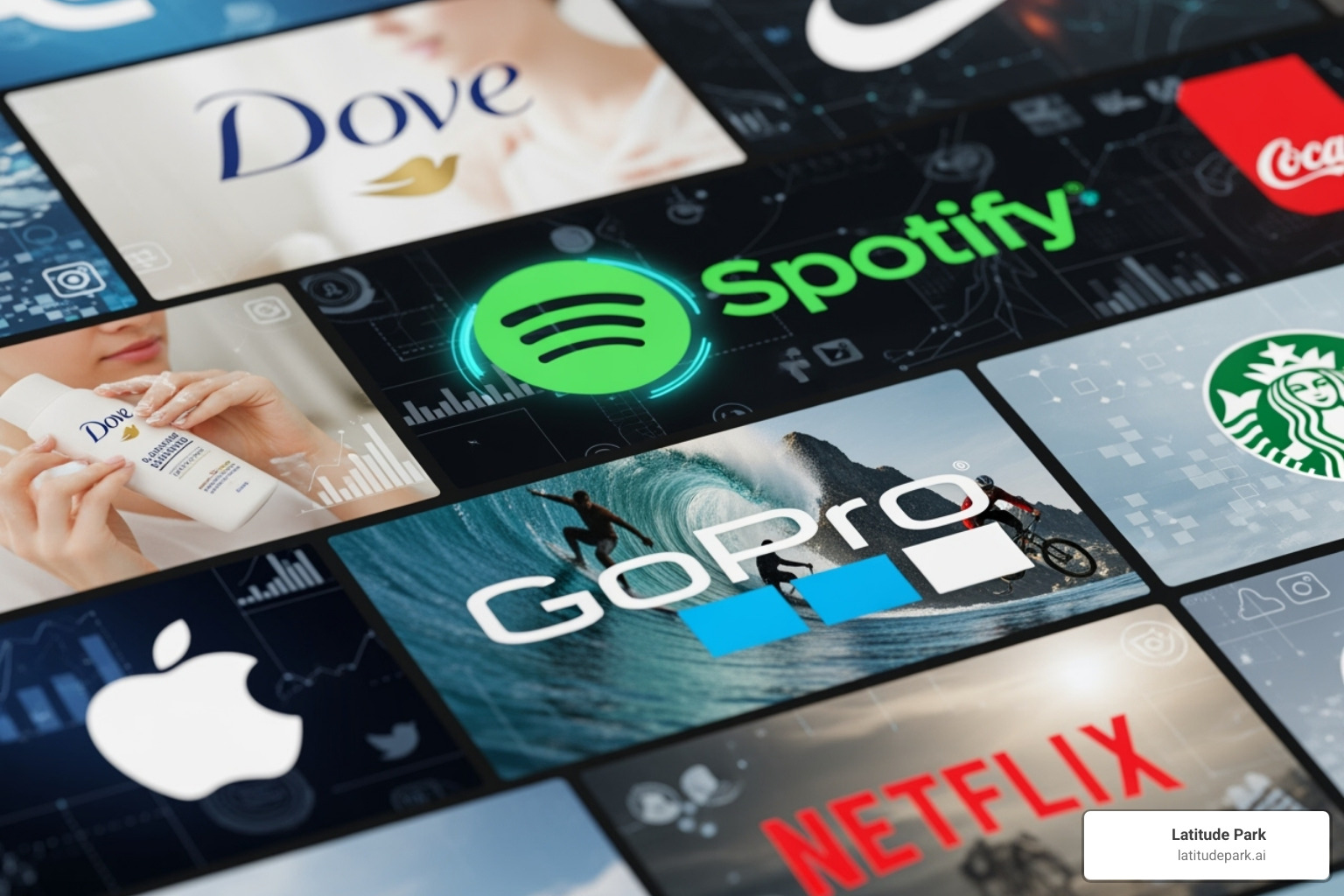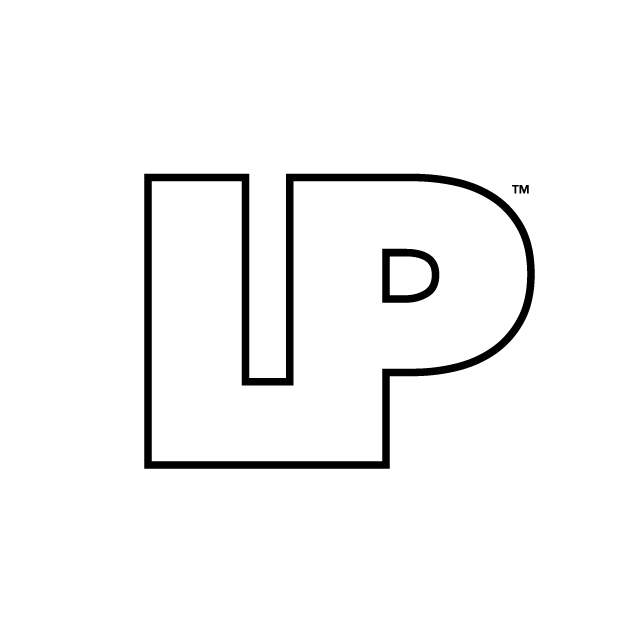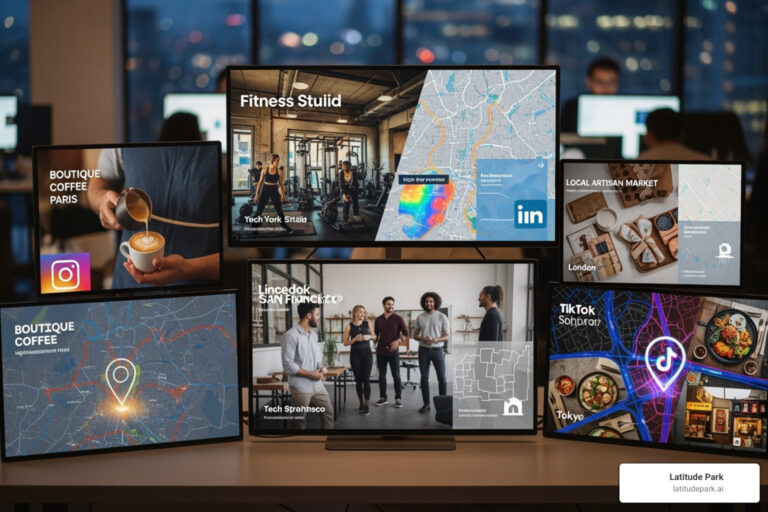Why Most Marketing Efforts Fail (And How Integration Fixes Everything)
An integrated digital strategy unifies all your marketing channels—from SEO and social media to email and paid ads—to deliver consistent messaging and create a seamless customer experience.
Quick Answer:
- What it is: A coordinated approach where all marketing channels work together.
- Why it matters: Customers interact with 6+ touchpoints before buying.
- Core benefit: Higher conversion rates (up to 24%) and better ROI.
- Key channels: SEO, PPC, content, social media, and email marketing.
- Main goal: Create consistent brand experiences across all customer interactions.
Many businesses suffer from a fragmented marketing approach. A customer sees a Facebook ad with one message, clicks to a website with another, and gets a contradictory email promotion. This disconnect confuses customers and wastes money. Research shows that over 70% of consumers prefer integrated campaigns, yet nearly half of companies lack a planned digital strategy.
The problem isn’t using multiple channels; it’s using them in isolation. When your marketing efforts compete against each other, you lose.
The solution is integration. Companies that adopt a unified strategy see dramatic results, with conversion rates as high as 24% and revenue increases over 26%. The principle is simple: the whole is greater than the sum of its parts.
As the founder of Latitude Park, I’ve spent over 15 years helping businesses, especially franchises, build cohesive strategies that drive measurable growth by ensuring all channels work in harmony.

Why Your Business Can’t Afford to Ignore an Integrated Strategy
In today’s crowded digital landscape, a disconnected marketing effort is a recipe for failure. An integrated digital strategy is essential for survival and growth. Most customers engage with a brand across six different online channels before making a purchase. If that journey isn’t smooth and consistent, you risk losing them.
An integrated strategy ensures that no matter how a customer finds you—search, social media, email, or an ad—they receive the same clear message. This consistency builds trust, improves brand recall, and provides a significant competitive advantage. The results are backed by data: companies using integrated campaigns see conversion rates jump by as much as 24% and revenues increase by over 26%. When all your marketing works together, the efforts are amplified, leading to better ROI and more sales.
To learn more, our Building a Strong Online Presence Guide offers deeper insights, and frameworks like The Five Rules of Digital Strategy can provide strategic direction.
The Problem with a Disconnected Approach
A fragmented marketing approach, where channels operate in silos, creates significant problems:
- Wasted Budget: When campaigns aren’t coordinated, you essentially compete against yourself. Ad spend is wasted if the landing page sends a different message, leading to poor conversion and lost revenue.
- Confused Customers: Inconsistent branding, messaging, or offers across platforms erode customer trust and dilute your core value proposition.
- Poor Data Insights: With each channel in its own bubble, it’s impossible to get a clear picture of the customer journey, making it difficult to optimize your strategy.
- Missed Opportunities: A lack of coordination means missing chances to cross-promote, nurture leads effectively, or use insights from one channel to boost another.
Surprisingly, 47% of companies still lack a planned digital marketing strategy, leaving them vulnerable to competitors with a more unified approach.
The Power of a Unified Brand Experience
Conversely, a unified brand experience, where every interaction is a logical step forward, transforms your business. This is the power of an integrated digital strategy.
- Seamless Customer Journey: Customers move smoothly from awareness to loyalty without confusing messages, dramatically improving their experience.
- Brand Recall and Recognition: A consistent voice, look, and message across all channels makes your brand instantly recognizable and memorable.
- Customer Loyalty: A positive and predictable brand experience encourages repeat business and referrals. Over 70% of consumers prefer to engage with brands through integrated campaigns.
- Improved Brand Reputation: A cohesive online presence signals that your business is reliable and professional. Learn more in our guide on Building and Managing Online Reputation.
- Increased Customer Lifetime Value: Loyal customers who have consistently positive experiences are likely to spend more over time, boosting their value to your business.
The Building Blocks: Core Channels of an Integrated Strategy
An integrated digital strategy works like a well-oiled machine, where each marketing channel supports and amplifies the others. At the center is your core brand message, with key channels radiating outwards. This synergy ensures consistent branding and delivers results far greater than any single channel could achieve alone.

Let’s explore the essential channels in this integrated approach:
Search Engine Optimization (SEO): The Foundation
SEO is the bedrock of your online presence, ensuring your website appears in search results when customers look for your services. It builds credibility and drives long-term, sustainable growth.
- Organic traffic: Drives highly qualified, unpaid traffic from users actively searching for your offerings.
- Brand authority: High search rankings signal that your site is a trusted source of information.
- Keyword strategy: Involves identifying and targeting the terms your audience uses.
- High-quality content: Valuable, relevant content is rewarded by search engines and users alike.
- Long-term growth: Unlike paid ads, SEO results compound over time, providing sustainable traffic.
SEO generates 53% of all web traffic, proving its foundational role in any digital strategy.
Pay-Per-Click (PPC) Advertising: The Accelerator
PPC offers immediate visibility and targeted traffic, accelerating your reach for specific campaigns or promotions.
- Immediate visibility: Your ads can appear at the top of search results almost instantly.
- Targeted traffic: Allows precise targeting based on keywords, demographics, and behavior.
- A/B testing messages: Quickly test ad copy and calls-to-action to find what resonates, informing your other marketing efforts.
- Remarketing: Re-engage users who have previously interacted with your site, nudging them toward conversion.
The average ROI for PPC is $2 for every $1 spent. When combined with SEO, the results are even more powerful. Learn more about How SEO and PPC Work Together.
Content Marketing: The Fuel for Your Integrated Digital Strategy
Content is the fuel that powers your entire strategy. It’s the value you provide across all channels, from blog posts and videos to case studies and ebooks.
- Storytelling: Connect with your audience on an emotional level and differentiate your brand.
- Value creation: Educate, entertain, or solve problems to establish your brand as a helpful resource.
- Thought leadership: Consistently providing valuable insights positions your brand as an industry expert.
- Influences the customer journey: Builds trust and credibility, leading to higher conversion rates.
For businesses looking to excel, understanding Why Hire a Content Marketing Agency can be a game-changer.
Social Media Marketing: The Conversation Starter
Social media is where your brand engages in two-way conversations and builds a community. It’s a vital channel for showcasing your brand’s personality and connecting with customers.
- Community building: Foster relationships and create a sense of belonging with your audience.
- Brand personality: Showcase your unique voice and values in a more casual setting.
- Customer engagement: Respond to comments and feedback to build rapport and loyalty.
- Social listening: Monitor conversations to gain valuable insights and identify trends.
Explore our The Ultimate Guide to Social Media Marketing to master platforms like Facebook and Instagram.
Email Marketing: The Relationship Builder
Email marketing remains one of the most effective channels for nurturing leads and building long-term customer relationships. It’s your direct line to your audience.
- Lead nurturing: Guide prospects through the sales funnel with targeted, relevant content.
- Personalization: Segment your audience to send personalized messages that make subscribers feel valued.
- Automation: Use automated sequences for welcome series, abandoned carts, and follow-ups.
- Customer retention: Keep existing customers engaged with exclusive offers and valuable content.
Email marketing is a powerful tool for driving sales, with an average conversion rate of 4.24%. For more information, see the Email Marketing Wikipedia entry.
Your 5-Step Blueprint for a Winning Integrated Digital Strategy
Creating an integrated digital strategy is a manageable process when broken down into clear, actionable steps. This is the same roadmap we use at Latitude Park to help businesses, particularly franchises, transform scattered marketing efforts into powerful, unified campaigns.

Step 1: Define Your Audience and Goals
Before any campaign, you need clarity on who you’re serving and what you want to achieve. If you’re talking to everyone, you’re talking to no one.
- Target Audience Research: Go beyond basic demographics to understand your audience’s routines, frustrations, and digital habits. Create detailed buyer personas that feel like real people.
- Set Measurable Objectives: Use the SMART framework (Specific, Measurable, Achievable, Relevant, Time-bound) to set clear targets, like “increase qualified leads by 30% in six months.”
- Define KPIs: Establish your Key Performance Indicators (KPIs) and conversion goals early to track what truly matters to your business.
Step 2: Audit Your Current Marketing Efforts
You can’t improve what you don’t measure. This step involves taking inventory of your current marketing assets and performance.
- Content and Channel Audit: Catalog all existing content (blogs, videos, social profiles) and review the performance of each channel. This will reveal what’s working and what isn’t.
- Competitor Analysis: Analyze what others in your space are doing well and where they fall short to identify opportunities for improvement.
- SWOT Analysis: Conduct an honest assessment of your digital Strengths, Weaknesses, Opportunities, and Threats to identify strategic gaps. The goal is to inventory your existing assets before building something new.
Step 3: Craft Your Consistent Core Message
This is where your brand finds its unified voice. Your core message is the DNA of your marketing, recognizable across every channel.
- Brand Voice: Define your brand’s personality—are you the helpful expert, the friendly neighbor, or the straight-talking professional? This voice must be consistent everywhere.
- Value Proposition: Clearly articulate the problem you solve for your customers. Make it simple enough for a stranger to understand in 30 seconds.
- Unique Selling Proposition (USP): Pinpoint what truly sets you apart from the competition and weave it into every message.
Consistent messaging ensures that your LinkedIn post, Instagram story, and email newsletter all feel like they came from the same brand, custom to each platform’s format.
Step 4: Plan Your Cross-Channel Campaign
Now it’s time to orchestrate your channels to work together. This is where your integrated digital strategy comes to life.
- Channel Selection: Be strategic. You don’t need to be everywhere—just where your audience is most active.
- Content Calendar: Create a detailed calendar that maps out what you’ll post, when, and how each piece of content connects to others across different channels.
- Message Tailoring: Adapt your core message to fit each platform’s culture and best practices while maintaining brand consistency.
- Budget Allocation: Allocate your budget based on each channel’s potential return and its role in the overall strategy. For franchises, this coordination is critical, as detailed in our guide to Digital Marketing Strategies for Franchises.
Step 5: Measure, Analyze, and Optimize with Data
Planning is useless without tracking results and learning from them. This is an ongoing cycle of improvement.
- Set Up Tracking: Properly configure Google Analytics and other tools to gather reliable data for data-driven decisions.
- Measure ROI: Use attribution modeling to understand how each touchpoint contributes to conversions, as customers often interact with multiple channels.
- A/B Testing: Continuously test headlines, images, and calls-to-action. Small improvements compound into significant gains.
- Conversion Rate Optimization (CRO): Regularly test and refine your landing pages and user experience to improve performance.
Use this data to constantly refine your strategy. The digital world changes fast, so stay flexible and keep optimizing.
Real-World Success Stories (And What You Can Steal)
The best way to understand the power of an integrated digital strategy is to see it in action. These brands orchestrated their efforts to create unified, impactful experiences that resonated with their audiences by focusing on emotional connection, personalization, and user engagement.

The Power of Emotion: Dove’s “Real Beauty Sketches”
Dove’s “Real Beauty Sketches” campaign tapped into a universal truth: women are often their own harshest critics. A forensic artist drew women based on their own descriptions and then based on descriptions from strangers. The stark, emotional contrast revealed how much more beautiful others saw them.
- Integrated Element: The emotional storytelling wasn’t just a video. The core message of self-acceptance was woven across social media, PR efforts, and their website, reinforcing the same brand values at every touchpoint.
- The Result: The campaign became the most-watched online ad of all time, garnering over 114 million views in its first month. This success came from strategic, multi-channel distribution.
The Power of Personalization: Spotify’s “Wrapped”
Spotify’s “Wrapped” campaign is a masterclass in data-driven marketing. Each year, it turns user listening data into a personalized, visually stunning, and highly shareable summary of their year in music.
- Integrated Element: The experience starts in the app but is designed for social sharing. This personalization turns millions of users into brand ambassadors, creating massive organic reach across Instagram, Twitter, and other platforms.
- The Result: Spotify Wrapped generated a 31% increase in social mentions and drives massive user engagement and customer loyalty year after year.
The Power of User-Generated Content: GoPro’s “Be a HERO”
GoPro understood its customers were buying an adventurous lifestyle, not just a camera. The “Be a HERO” campaign leveraged this insight through user-generated content.
- Integrated Element: Instead of creating ads, GoPro encouraged customers to submit their own videos. They curated the best content and featured it across their social media, website, and even TV commercials. This customer-centric marketing made customers the storytellers.
- The Result: This approach fostered genuine community building and authenticity. GoPro saw a 38.1% revenue increase during the campaign’s peak, proving the financial impact of building a loyal community of brand advocates.
Frequently Asked Questions about Integrated Digital Marketing
Here are answers to some of the most common questions we receive about integrated digital strategy.
What’s the difference between multichannel and integrated marketing?
Many use these terms interchangeably, but the difference is crucial. Multichannel marketing is simply using multiple channels (e.g., a website, Facebook page, and email list). However, these channels often operate in separate “silos,” with inconsistent messaging.
Integrated marketing, on the other hand, ensures all those channels work together in harmony. It’s the difference between individual musicians playing their own songs and an orchestra playing a symphony. An integrated digital strategy coordinates every channel to tell the same story and guide the customer through a single, seamless experience. The key difference is strategic coordination and consistency.
How much does an integrated digital strategy cost?
There’s no single price tag. The cost of an integrated digital strategy depends on factors like the scale of your campaigns, the channels you choose, and whether you manage it in-house or hire an agency. Highly competitive industries may also require a larger investment.
However, the focus should be on Return on Investment (ROI). An effective integrated strategy is designed to save money by eliminating wasted ad spend from fragmented efforts. By making all marketing more efficient, it leads to higher conversion rates (up to 24%) and can increase revenue by over 26%. When channels like PPC (with an average ROI of $2 for every $1 spent) are integrated, those returns are amplified. It’s an investment in measurable, sustainable growth.
Can a small business create an effective integrated digital strategy?
Absolutely. Integration is about smart strategy, not a massive budget. A small business can create a highly effective integrated digital strategy by focusing on a few key principles:
- Focus on consistency: Ensure your website, social media, and emails all share the same message, voice, and visual style. This builds trust.
- Choose channels wisely: You don’t need to be everywhere. Focus your energy on the few channels where your target audience is most active and ensure they work together.
- Leverage free tools: Many platforms offer free analytics and scheduling tools to help with integration and measurement.
- Start small and iterate: Launch your strategy, monitor the results, and refine your approach based on what you learn. A well-coordinated strategy can allow a smaller business to outmaneuver larger competitors who may have bigger budgets but lack strategic cohesion.
Conclusion: Unifying Your Marketing for Real Growth
A scattered marketing approach won’t deliver results. An integrated digital strategy is the key to changing your marketing from a collection of separate pieces into a powerful, unified engine for growth.
This unified approach creates a seamless customer experience, builds unwavering brand consistency, and ultimately maximizes your ROI for long-term success. The old saying, “the whole is greater than the sum of its parts,” is especially true in marketing. When your SEO, PPC, content, social media, and email all work together, they create a symphony that resonates with your audience.
For complex businesses like multi-location franchises, a cohesive strategy is essential for clear communication and scalable growth. At Latitude Park, we specialize in helping franchises steer this complexity, crafting custom digital marketing solutions that ensure every touchpoint reinforces your brand story.
Ready to stop scattering your efforts and start seeing measurable growth? Explore our digital marketing agency services and let’s work together to unify your marketing for lasting success.









